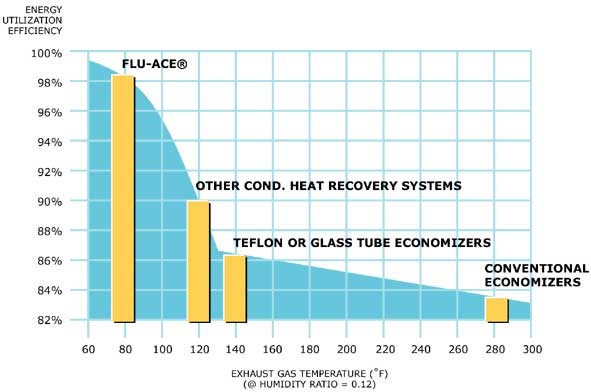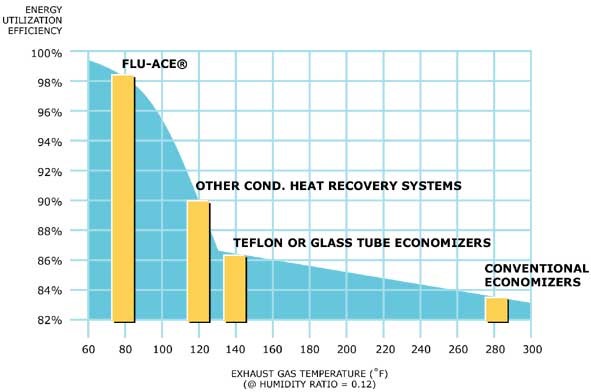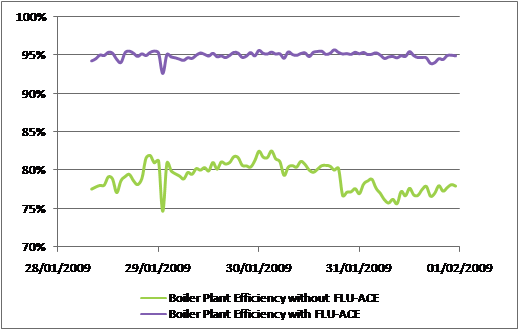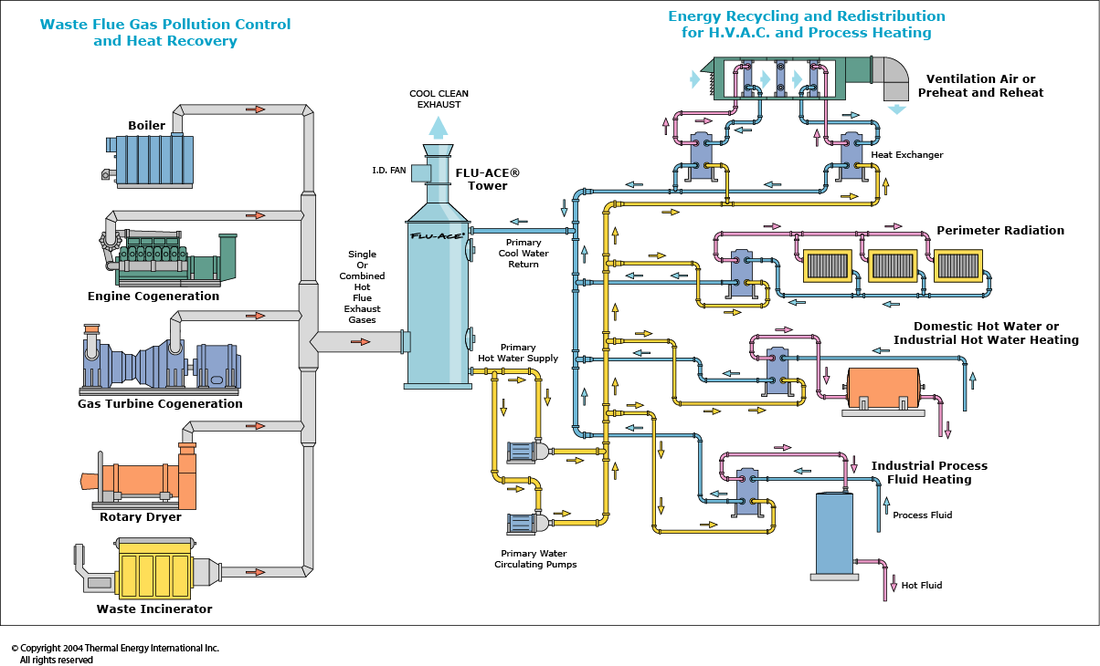|
|
FLU-ACE® frequently asked questions
- What is a FLU-ACE heat recovery system?
- I already have an economizer – does FLU-ACE still apply?
- How does a FLU-ACE work? And why is it much more efficient than the typical feedwater economizer?
- How do I know if FLU-ACE is right for my facility?
- What is the difference between a direct-contact and an indirect-contact economizer, and what are the advantages and disadvantages of each?
- What is the typical efficiency of an industrial boiler and how can FLU-ACE technology help improve the efficiency of my boiler plant?
- What are the typical waste heat exhaust gas sources suitable for FLU-ACE heat recovery?
- What can the recovered energy be used for?
- What is the typical payback on a FLU-ACE investment?
- I have multiple boilers in my plant. Do I need a dedicated FLU-ACE for each boiler exhaust?
- What are the maintenance requirements?
- Will the FLU-ACE impact my boiler, heating, or process operation?
- How does installing a FLU-ACE on a steam boiler compare with replacing a steam boiler with a hot water boiler?
- I have a hot water boiler, does the FLU-ACE still apply?
If the information below does not answer the questions you have or you would like additional information, please contact us and we will answer your specific questions and provide you with any literature that may help you.
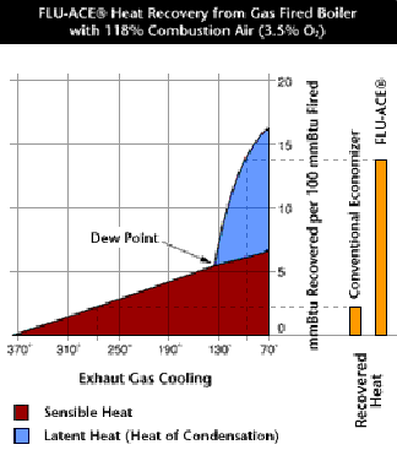
1. What is a FLU-ACE heat recovery system?
FLU-ACE is a direct contact condensing heat recovery system. It recycles the heat normally lost through flue gas exhaust, and uses it to preheat a heat sink – this could be water for your space heating, domestic hot water, boiler feed water, or outside air heating.
By replacing the existing load with our recovered energy, many industrial and institutional organizations have been able to prove savings of 20% on their fuel bills
It is called a “direct contact” system as the water being heated in the FLU-ACE directly contacts the hot gas leaving the boiler (or other process exhaust). This provides the absolute optimal heat recovery and is much more efficient than an indirect contact heat exchanger, which heats water which is in a tube by passing the exhaust gas outside of the tube (much like a typical boiler feedwater economizer). Although the water quality is barely affected at all through this direct contact with the flue gas, where no contamination of the water can be tolerated, the FLU-ACE direct-contact water can be recirculated through a plate and frame heat exchanger to heat the critical process water indirectly (keeping it clean) or Thermal Energy can provide an alternative indirect (finned-tube type) condensing heat recovery unit design.
It is called a “condensing” heat recovery system because it cools the exhaust gas to below its’ dew point, condensing and removing water from the flue gas. When fuel is burned it produces CO2 and H2O vapour. This condensing aspect is critical as for natural gas boilers typically 10% to 13% of the heating value of the gas leaves the stack in the form of water vapour, and this heat cannot be recaptured without condensing the water vapour in the flue gas. This is why non-condensing systems cannot result in boiler efficiencies over 85% on a higher heating value basis. In fact, due to this effect, there is less energy available from a typical flue gas when it is cooled from 400 °F to 140 °F (200 °C to 60 °C) than when it is cooled from 140 °F to 100 °F (60 °C to 40 °C). Due to all the latent heat being available below 140 °F (60 °C), there is more energy available in the 40 °F (20 °C) after the dew point than in the 260 °F (130 °C) before it!
2. I already have an economizer – does FLU-ACE still apply?
Definitely. Many boiler plants already have boiler feedwater economizers, but very few have condensing economizers like the FLU-ACE. Boiler feedwater economizers are placed in the boiler exhaust stack and heat boiler feedwater after the deaerator and before the boiler. Condensing economizers will have exhaust gas temperatures of between 70°F and 130°F (roughly between 20°C and 60°C), whereas feedwater economizers typically exhaust at well over 200°F (over 100°C). A FLU-ACE can be installed after a feedwater economizer is installed, and is fully complementary. In fact a FLU-ACE can bring many times more savings (3 to 5 times) than the feedwater economizer can, even if installed after it.
3. How does a FLU-ACE work? And why is it much more efficient than a typical feedwater economizer?
FLU-ACE uses direct contact gas-to-liquid mass transfer and heat exchange. It condenses almost all of the water vapour (steam) from the exhaust, and this latent heat is the source of the bulk of the waste heat available in a boiler flue gas.
“Sensible” heat refers to energy that can be released through a temperature change. Heating water from 32°F to 212°F (0°C to 100°C) is a change in “sensible” heat. “Latent” heat refers to energy stored or released in a phase change, such as the heating that is done when steam changes from vapor to water, without any temperature change. As it turns out, the energy released when a pound of steam turns into a pound of water, all happening at 212°F (100°C) (no temperature change, so this is latent heat) is some 5 times the energy released when that same pound of water is cooled from 212°F to 32°F (100°C to 0°C). All this to say there is a lot of energy released in the phase change from water vapor to liquid water.
Therefore, condensing heat recovery technology, which can capture latent heat, is much more efficient than the typical feedwater economizer, which can only capture sensible heat. As a matter of fact, with regards to overall boiler plant efficiency, FLU-ACE is able to provide a 10% to 15% improvement, while a typical feedwater economizer provides an improvement of 2% to 4%.
4. How do I know if FLU-ACE is right for my facility?
The FLU-ACE can recover heat to be used for space heating, water heating, or air heating. If your facility does any of these things, then FLU-ACE may be a good fit. The answer then lies in the payback, not just in the knowledge that there is someplace that the waste heat can be used. Since this is a question that includes many aspects beyond just the equipment price and knowledge of the waste heat users, Thermal Energy provides a complete service, including data gathering, project development, turn-key project cost development, and turn-key implementation. If you don’t know the answer to this question, and you know you have suitable uses for the waste heat, give Thermal Energy a call and we can help, step by step, to determine if an economical FLU-ACE project exists at your facility. We do not just provide equipment pricing and savings estimates, we help your facility develop a high quality and accurate business case incorporating all costs and savings related to the potential FLU-ACE project. We do much more than provide pricing – Thermal Energy helps make projects happen to the benefit of your company’s pocketbook, and the environment. So give us a call!
5. What is the difference between a direct-contact and an indirect-contact economizer, and what are the advantages and disadvantages of each?
Quite simply, neither of these technologies is the right choice in all cases, so a proper analysis should consider both before making a decision. Thermal Energy can provide both types of systems, and will look at the pros and cons of each type for your facility to help make the right choice.
Some advantages and disadvantages of the two types of systems include:
Direct Contact
- Longer life (20 to 30 years) due to neutralization of slightly acidic condensate formed within the spray tower;
- Can produce higher water temperatures with more humid exhausts;
- Can accept almost any kind of exhaust as a heat source, including oil boilers and dirty process exhausts, in addition to natural gas;
- Can deliver more savings when there is lots of heat sink (user) with relatively low (140° to 170°F) temperature setpoints;
- Significant pollution control benefit (effectively a wet scrubber, over 90% reduction of acid gases and over 50% removal of particulate matter at end of pipe), in addition to reduction of fuel use; and,
- Less simple process, typically requires a new pump (due to loss of liquid pressure in the spray tower) and often requires a hot water recirculating loop.
- Shorter life (5 to 15 years) due to formation of acid droplets on the outside of tube materials, resulting in potential spot corrosion due to the acidity of the droplet and the dielectric effect;
- Can produce higher temperature water with hotter, dryer exhausts;
- Best applied to clean, non-acidic exhausts as heat sources (natural gas exhaust);
- Can deliver more savings when there is less heat sink (user) with relatively high (170° to 200°F) temperature setpoints;
- Limited pollution control benefit in addition to reduction of fuel use;
- Simpler process, typically no need for new pump or hot water recirculating loop;
6. What is the typical efficiency of an industrial boiler and how can FLU-ACE technology help improve the efficiency of my boiler plant?
The boiler efficiency, defined as steam produced / fuel energy consumed, typically ranges from 70% to 80%.
15% to 20% of the energy used in a boiler plant is lost up the boiler stack. Thermal Energy’s FLU-ACE condensing heat recovery technology effectively recovers this waste energy and uses it to preheat a heat sink – this could be water for your space heating, domestic hot water, boiler feed water, or outside air heating. This can result in overall boiler plant efficiencies of well over 90%.
The boiler efficiency, defined as steam produced / fuel energy consumed, typically ranges from 70% to 80%.
15% to 20% of the energy used in a boiler plant is lost up the boiler stack. Thermal Energy’s FLU-ACE condensing heat recovery technology effectively recovers this waste energy and uses it to preheat a heat sink – this could be water for your space heating, domestic hot water, boiler feed water, or outside air heating. This can result in overall boiler plant efficiencies of well over 90%.
7. What are the typical waste heat exhaust gas sources suitable for FLU-ACE heat recovery?
The FLU-ACE is effectively a wet scrubber used for heat recovery, and as such it can accept a very wide variety of process exhausts as heat sources. With natural gas boiler exhausts the system is effectively bulletproof, with a lifespan of over 30 years. FLU-ACE can also be applied to reciprocating engine and gas turbine exhausts, oil boilers, biomass boilers, pulp and paper and tissue machine dryer section exhausts, smelt dissolving tank exhausts, food and beverage process steamer, cooker, and fryer exhausts, evaporators, sterilizers, casting oven exhausts, incinerators / oxidizers, and more. Whatever your heat source is, if you can provide information about the source, Thermal Energy can advise as to the suitability of the FLU-ACE and other heat recovery options.
8. What can the recovered energy be used for?
Where there is a great deal of use for waste heat, FLU-ACE direct contact condensing heat recovery can provide maximum benefits. Typically the recovered energy can be used for: process make-up water heating, boiler make-up water heating, process liquid heating, dryer make-up air heating, combustion air heating, ventilation make-up air heating, mixed air heating, perimeter radiation heating, and domestic hot water heating. Note also that the FLU-ACE does not have to reach setpoint temperatures, although it often can. It can also preheat cold streams up to 140°F (60°C) or more, and then existing heating systems can bring the stream up to its’ required setpoint.
9. What is the typical payback on a FLU-ACE investment?
Depending on the scale of the project, and on the local gas price, our customers typically enjoy full payback on a FLU-ACE investment in one to five years, and continued savings throughout the unit’s 20 years plus operational life. Larger systems at sites with high fuel / gas costs will be closer to the 1 or 2 year payback range, and smaller systems where the fuel source is relatively inexpensive will be closer to a payback of 4 or 5 years. A site having a steady load all year long (24/7) also yields a better payback than a site having a seasonal load, or than a site operating less than 24 hours per day.
Note also that Thermal Energy International can bring financing to the table for our projects, often resulting in a payment plan that results in net positive cash flow from day one. Clients can pay for the energy output of the system, paying much less than is paid for the previous energy used to provide heat, resulting in cash positive operation right from the start.
10. I have multiple boilers in my plant. Do I need a dedicated FLU-ACE for each boiler exhaust?
No. Unlike a typical feedwater economizer, the varying flow of flue gases emitted from multiple boilers can be effectively processed by a single FLU-ACE. This means a lower initial investment, lower operating costs and a higher return on investment with FLU-ACE. In fact a single FLU-ACE has been successfully used to recover energy from as many as 7 boilers at once, and a single FLU-ACE has been used to recover energy from 3 different process exhausts.
11. What are the maintenance requirements?
Minimal. The FLU-ACE heat recovery unit itself typically (on natural gas boiler / natural gas fired dryer exhausts) requires no maintenance at all. Other than the required fan and pump, and a few temperature sensors, there are no maintenance requirements. Our clients have commented on the low maintenance that the system demands. With boiler plants and process operations being short-staffed, and with employees having no time to take on extra duties, the FLU-ACE is a great addition, and is typically described as a “low-to-no maintenance system”.
12. Will the FLU-ACE impact my boiler, heating, or process operation?
Not at all. The most important thing to our clients – even more important than energy savings - is that their operations continue smoothly without interruption. Thermal Energy implements FLU-ACE systems in a manner that ensures this. A typical FLU-ACE application integrates with the heat source and the heat sink.
On the heat source side, the FLU-ACE will not create any back-pressure or complications with the boiler or process exhaust. Thermal Energy’s standard configuration includes leaving the existing stack in place and wide open (no damper or other obstructions), and simply involves installing a take-off / tee section from the stack, and drawing as much stack gas as is required to meet the heat sink demand with our variable speed drive fan. In this way, even in the event of a shut-down of the FLU-ACE system, the stack gas simply flows back through the existing stack as it did before FLU-ACE installation, without any dampers opening or closing.
On the heat sink side, Thermal Energy prefers not to remove any of the client’s existing heating systems. Heat recovered by the FLU-ACE is delivered to process streams upstream of existing heating systems (upstream of existing steam heat exchangers or steam injection, or upstream of existing air heating coils or burners). In this way the FLU-ACE provides redundancy, and if the FLU-ACE free energy does not meet setpoint, or is not available due to FLU-ACE or heat source shut down, the existing heating systems automatically kick in and take over the heat loads, as they did before FLU-ACE installation.
In these ways the FLU-ACE will not upset operation at the heat source or at the heat sinks. The most important thing to our clients is their successful day-to-day operation, and reaping the benefits provided by a FLU-ACE system will not interfere with this.
13. How does installing a FLU-ACE on a steam boiler compare with replacing a steam boiler with a hot water boiler?
Using a FLU-ACE on a steam boiler will yield a superior return on investment that retrofitting a boiler plant and site to use hot water only, and in many cases it will also provide higher boiler plant efficiency and savings.
When replacing or adding boilers to a boiler plant, facilities have many options to consider, including replacing steam boilers with new steam boilers, or with condensing or noncondensing water heaters, or combining these options with heat recovery. The answer is not the same for all boiler plants. Depending upon existing heating infrastructure and operating temperatures, different scenarios present the best solution for different facilities. By carefully considering the steam boiler, water heater, and heat recovery technologies available in tandem with existing infrastructure, an educated decision can be made and will result in operating the boiler plant consistently at efficiencies well above 90%.
In many cases, the cost of retrofitting 100% of a facility’s infrastructure to allow for use of hot water instead of steam is prohibitive. But often the same, or even better, boiler plant efficiency can be achieved by retrofitting only 20% of the facility’s heating infrastructure to use hot water (and meeting this heat load with free hot water recovered in a FLU-ACE system) and keeping 80% of the infrastructure on steam. For more information on this subject see our White Paper entitled “Optimizing Boiler Plant Efficiency on Boiler Replacement” as presented at the Midwest Healthcare Engineering Conference, Indiana Convention Center, November 7 - 9, 2012. Thermal Energy can explore these options with you before you make the expensive decision to completely convert to hot water.
14. I have a hot water boiler, does the FLU-ACE still apply?
Yes. Most hot water boilers are still throwing 10% to 15% of their energy up the stack. Even many condensing hot water boilers are not connected with a heating system that allows them to operate at exhaust temperatures which provide 90% or greater efficiency (exhaust temperatures of 120°F to 80°F (50°C to 30°C). So typically if a hot water boiler is in place, the opportunity for a FLU-ACE is still the same, or only slightly reduced, when compared to a steam boiler. All you need to know is the boiler exhaust temperature – if it is higher than the range listed above, the opportunity for a FLU-ACE is still strong.
|
Check out some success stories
|
See sector-specific applications
|
Learn more about FLU-ACE
|

